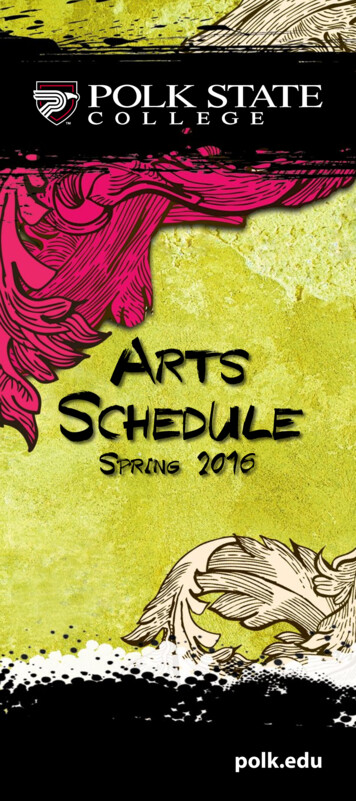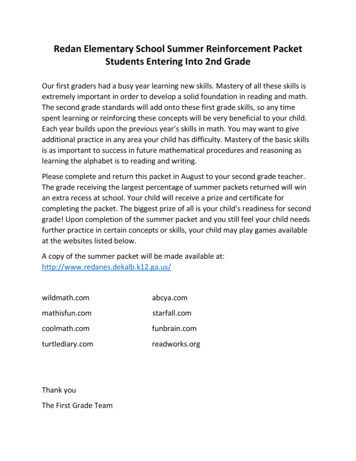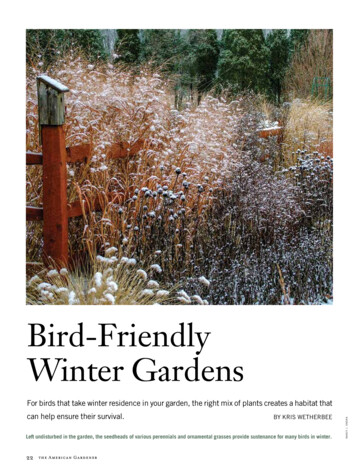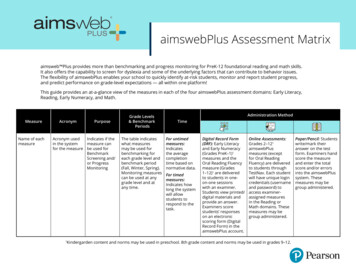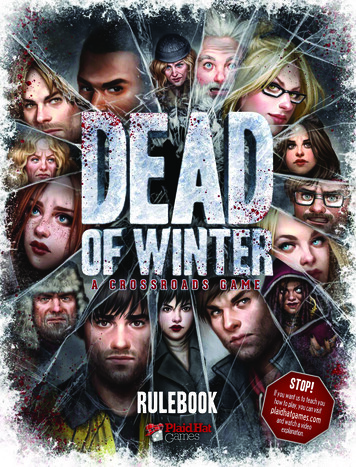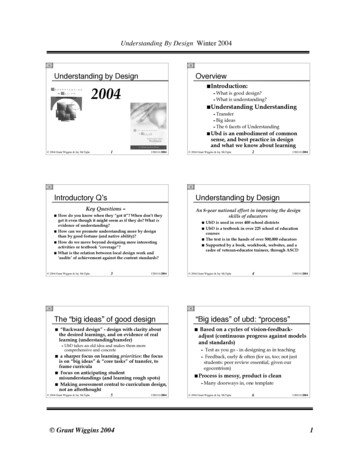
Transcription
Understanding By Design Winter 2004Understanding by DesignOverview Introduction: What is good design? What is understanding?2004 Understanding Understanding Transfer Big ideas The 6 facets of Understanding Ubdis an embodiment of commonsense, and best practice in designand what we know about learning 2004 Grant Wiggins & Jay McTighe1UBD 01/2004Introductory Q’s How do you know when they “got it”? When don’t theyget it even though it might seem as if they do? What isevidence of understanding?How can we promote understanding more by designthan by good fortune (and native ability)?How do we move beyond designing mere interestingactivities or textbook “coverage”?What is the relation between local design work and‘audits’ of achievement against the content standards? 2004 Grant Wiggins & Jay McTighe3UBD 01/2004The “big ideas” of good design “Backward design” - design with clarity aboutthe desired learnings, and on evidence of reallearning (understanding/transfer) UbDtakes an old idea and makes them morecomprehensive and concreteUBD 01/20045 Grant Wiggins 2004An 8-year national effort in improving the designskills of educators UBD 01/2004UbD is used in over 400 school districtsUbD is a textbook in over 225 school of educationcoursesThe text is in the hands of over 500,000 educatorsSupported by a book, workbook, websites, and acadre of veteran-educator trainers, through ASCD 2004 Grant Wiggins & Jay McTighe4UBD 01/2004“Big ideas” of ubd: “process” Based on a cycles of vision-feedbackadjust (continuous progress against modelsand standards) a sharper focus on learning priorities: the focusis on “big ideas” & “core tasks” of transfer, toframe curricula Focus on anticipating studentmisunderstandings (and learning rough spots) Making assessment central to curriculum design,not an afterthought 2004 Grant Wiggins & Jay McTighe2Understanding by DesignKey Questions – 2004 Grant Wiggins & Jay McTighe Test as you go - in designing as in teachingFeedback, early & often (for us, too; not juststudents: peer review essential, given ouregocentrism) Process Manyis messy, product is cleandoorways in, one template 2004 Grant Wiggins & Jay McTighe6UBD 01/20041
Understanding By Design Winter 20043 key understandings - aboutunderstanding:Understanding is about wise useof knowledge and skill effective “transfer” Understandings are counterintuitive inferences, not just more“knowledge” Without understanding: amnesiaand inert knowledge 2004 Grant Wiggins & Jay McTigheUBD 01/20047 4 key understandings - aboutdesign: A sound plan refers to the few key desired learnings,the desired output; not the many ‘teachings’ andactivities, the inputsThe design must be transparent to the learner; thestudent must understand the prioritiesWe have to design backward from desired performance,not desired content mastery - content mastery is ameans to abilityThe best plans are both purposeful and flexible: thegreater the clarity of our goals, the easier it is to adjustin a timely and effective way 2004 Grant Wiggins & Jay McTighe8Focus here: The non-contactrole of plan & design of workTeachers wear many hats: Instructor Coach Friend Evaluator Disciplinarian AdvisorInstructionalSkillsPlanning&Design ofClassCurriculum &ManageAssessmentment 2004 Grant Wiggins & Jay McTighe9UBD 01/20043 Stages of(“Backward”) Design3. Plan learning experiences& instruction Grant Wiggins 200410UBD 01/2004Identify content2. Determine acceptable evidence11 2004 Grant Wiggins & Jay McTigheCoachingSkillsTypical Error in Design1. Identify desired results 2004 Grant Wiggins & Jay McTigheUBD 01/2004UBD 01/2004Brainstorm activitiesWithout checkingfor alignmentCome up with an assessment andlink it to some Standard 2004 Grant Wiggins & Jay McTighe12UBD 01/20042
Understanding By Design Winter 2004Design work is iterative,non-linearIt doesn’t matterwhere you begin orhow you proceed as long as thedesign ends upwith all elementsaligned! 2004 Grant Wiggins & Jay McTighe!STAGE 1:GUSTAGE 2:T13UBD 01/2004UBD 01/2004roles & limits ofthe 3 branchesof government 2004 Grant Wiggins & Jay McTighe 2004 Grant Wiggins & Jay McTighe idiomaticexpressions,and wiselyusing thembig idea/core task 17 Grant Wiggins 2004foundationalknowledgeUBD 01/2004big idea16UBD 01/2004Some questions for identifyingtruly “big ideas””nice to know”foundationalskillUBD 01/2004”nice to know”The dilemmasof a representativedemocracy andseparation ofpowersEstablishing Intellectual priorities:World Language exampleability to usekey verbs in thetarget language14Authors ofThe Federalistbig idea &core taskHow to say‘I am hungry’“big ideas”& core tasks worthexploringin depthEstablishing Intellectual priorities:Social Studies Examplefoundationalskill15foundationalknowledge & skill 2004 Grant Wiggins & Jay McTighe”nice to know”Equivalence,being able to solveproblemsusing itimportant toknow & doBig ideas& core tasksLHow to group& regroup”nice to know”OESTAGE 3:Definition ofdistributive propertyworth beingfamiliar withQEstablishing Intellectual priorities:Math Example 2004 Grant Wiggins & Jay McTigheEstablishing Intellectual prioritiesaround “Big Ideas” & “Core Tasks”Does it have many layers and nuances, notobvious to the naïve or inexperienced person?Can it yield great depth and breadth of insightinto the subject? Can it be used throughout K-12?Do you have to dig deep to really understand itssubtle meanings and implications even if anyonecan have a surface grasp of it?Is it (therefore) prone to misunderstanding as wellas disagreement?Are you likely to change your mind about itsmeaning and importance over a lifetime?Does it reflect the core ideas in a field or in life, asjudged by experts? 2004 Grant Wiggins & Jay McTighe18UBD 01/20043
Understanding By Design Winter 2004Some “Big Ideas”Q’s to Identify “Core Tasks”:concepts: migration, adaptation, place value, function, equity,text themes: “Good triumphs over evil”, “the outsider”, “the morewe learn the less we know” debates: “Nature vs. nurture” “offense vs. defense” perspectives: America as seen by ourselves, our allies, and ourfoes; Euclidean vs. non-euclidean geometry paradox: freedom involves responsibility, no force is acting ona body moving at a fast constant speed theory: form follows function; you are what you eat, less ismore (design, arts) assumption: the text has meaning, “Occam’s Razor” (i.e. beliefthat the best scientific explanation is the simplest), history as amarch of human progress, anything can be measured if we canidentify what it is we want to measure 2004 Grant Wiggins & Jay McTigheUBD 01/200419 Core tasks are 2nd key toprioritized learning by design UBD 01/2004Don’t confuse the drills with thegame (authentic performance)‘Drill-tests’ exercises The ‘game’ - realproblemsOut of contextDiscrete, isolatedelementUnrealistically set upand promptedDoesn’t transferwithout practiceadapting it to thegame itself 2004 Grant Wiggins & Jay McTighe 23 Grant Wiggins 2004 2004 Grant Wiggins & Jay McTighe20UBD 01/2004Examples from various fields:What are realistic options, constraints, andopportunities available in such work?What are the key genres of performance in yoursubject(s)? What might be the ‘decathlon’ inyour program area, that might anchor thecurriculum?21 What task(s) provide credible answers to: “Why are welearning this? What does it help you do?”What tasks require a full repertoire of the many discreteskills and facts we teach?What complex tasks do people out in the world getcalled upon to do - on their own? What are the kinds ofchallenges and conditions they face in the field?What work requires transfer - the thoughtful use of arepertoire, not just cued, simple plug-in or roteresponse?Is this the kind of task that can and must recur K-12because it is the essence of the discipline or field?Crafting a coherent, credible, and supported narrativeof what happened, despite conflicting and incompleteaccounts (social studies) Designing and de-bugging your own experiments(science) Navigating successfully in a foreign language andculture (world language) Figuring out, on your own, what an author might havemeant, and saying why (lang. Arts) Developing mathematical models of messy phenomena(math, science, social science) Speaking to different audiences and purposes,including highly challenging situations 2004 Grant Wiggins & Jay McTigheUBD 01/200422 What does it mean to do the subject, to have yourknowledge ‘tested’ in the world? 2004 Grant Wiggins & Jay McTighe Core tasksDefined: “The most important complexperformances, in realistic contexts, in each field” Ask: What do the discrete skills and facts enable?In context, with allits messiness andinterest valueRequires arepertoire, usedwiselyNot prompted: youjudge what to do,whenUBD 01/2004Find lots of ideas in thelanguage of the StandardsKey verbs suggest the important tasksKey nouns reflect the big ideasImportant to anchor curriculum in coretasks which recur K-12 to avoid overlydiscrete teaching of skills Important to frame curriculum aroundessential questions to ensure Big Ideas arehighlighted and used to frame ‘content’goals 2004 Grant Wiggins & Jay McTighe24UBD 01/20044
Understanding By Design Winter 2004to teach for understanding is tocoach for transfer, not just recallOhio Examples Demonstrate that motion is a measurable quantity thatdepends on the observer's frame of reference anddescribe the object's motion in terms of position,velocity, acceleration and time.Evaluate the limitations and the opportunities thatresult from decisions made in the past including: a. Electoral College;b. Direct election of senators;c. Income tax;d. Length of terms of elected and appointed officials. 2004 Grant Wiggins & Jay McTighe25UBD 01/2004“Students develop flexible understanding of when, where, why, andhow to use their knowledge tosolve new problems if they learnhow to extract underlyingprinciples and themes from theirlearning exercises.”- How People Learn, p.22427UBD 01/200430 inchesWhat is thediagonalmeasurement ofthe TV screen?2535 50 70 1200 8th-grade: 25% correct 2004 Grant Wiggins & Jay McTighe12th-grade: 42% correct29 Grant Wiggins 2004 Local/classroom assessment is consistently too low-leveland narrow – not focused on transfer, but ‘plugging in’Adaptation of knowledge, based on understandingthe big ideas ‘underneath’ specific content;Grappling with new or unfamiliar elements, uses,or obstacles 2004 Grant Wiggins & Jay McTighe26UBD 01/2004Controversial transfer item34 A straw is placed into arectangular box that is 3inches by 4 inches by 8inches, as shown in theaccompanying diagram. Ifthe straw fits exactly intothe box diagonally fromthe bottom left frontcorner to the top rightback corner, how long isthe straw, to the nearesttenth of an inch? 2004 Grant Wiggins & Jay McTigheOver 70% wrong!28UBD 01/2004MCAS test item: 10th-gradeEnglish reading itemA NAEP item, same topic40 inchesTasks with minimal cues and scaffolding, unliketypical test items: can the learner imagine and judgewhich knowledge & skills are required here? How people learn, for transfer 2004 Grant Wiggins & Jay McTigheTransfer requires UBD 01/2004A fellow fourth grader broke the news to me after she saw myeffort on a class assignment involving scissors and construction paper.“You cut out a purple bluebird,” she said. There was no reproach in hervoice, just a certain puzzlement. Her observation opened my eyes—not that my eyes particularly help—to the fact that I am colorblind. Inthe 36 years since, I’ve been trying to understand what that means. I’mstill not sure I do .Unlike left-handers, however, we seem disinclinedto rally round our deviation from the norm. Thus there’s no readysource of information about how many presidents, or military heroes,or rock singers have been colorblind. Based on the law of averages,though, there must have been some. We are everywhere, tryingto cope, trying to blend in. Usually we succeed. Until someone spotsour purple bluebirds. Then the jig is up. 2004 Grant Wiggins & Jay McTigheUBD 01/2004305
Understanding By Design Winter 2004The most wrong item on thetest: 70% incorrect: “Big Ideas” defined:This selection is best described asa biography. B. a scientific article. C. an essay. D. an investigative report. Many students said it could not be an essaybecause “it was funny” and because “it hadmore than 5 paragraphs.” 2004 Grant Wiggins & Jay McTighe31UBD 01/2004The big ideas provide a way toconnect, recall, apply knowledge 2004 Grant Wiggins & Jay McTigheBig Idea:A system 2004 Grant Wiggins & Jay McTighe33Pointing to big ideas viaessential questions35 Grant Wiggins 2004 Like Bill ofRightsUBD 01/2004Q“How does one lead children to discoverthe powers and pleasures [of rethinking]?Through organizing questions. Theyserve two functions: they put perspectiveback in the particulars. and they oftenserved as criteria for determining wherestudents were getting, how well theywere understanding, whether anythingnew was emerging.”– Jerome Bruner 2004 Grant Wiggins & Jay McTigheUBD 01/2004Look for “big ideas” in key concepts andissues of judgment in using skill Like rulesof a gameof many powerfulinferences from asmall setof givens32Big ideas - in skill areasThe ParallelpostulateS.A.S.CongruenceA2 B2 C2Is it a Big Idea? Does it –have lasting value, with transfer to otherinquiries? serve as a key concept for making important facts,skills, and actions more connected, coherent,meaningful, useful? epitomize “core” (not “basic”) insights in asubject or discipline? require “uncoverage” (since it is an abstract oroften-misunderstood idea)? A.UBD 01/2004strategy & tactics: “opening up space” in sportswhy it works: “place value in base 10”in adding or subtracting; “continuity” in numbers andnumber linePurpose & value: “self-sufficiency” as foundation of “lifeskills”; “meaning” inprint (as a rationale for actively using multiple strategiesin decoding text) 2004 Grant Wiggins & Jay McTighe34Essential QuestionsUBD 01/2004QWhat questions – are important to argue about?are at the heart of the subject?recur - and should recur?raise more questions – provoking and sustainingengaged inquiry?must become habits of mind when we face realproblems?often raise important conceptual or strategic issues inthe subject?can provide organizing purpose for meaningful &connected learning? 2004 Grant Wiggins & Jay McTighe36UBD 01/20046
Understanding By Design Winter 2004Class rankWhat is Fair?Essential Questionsexamples –What’s the pattern? How do I know? Are the exceptionsanomalies or clues that it’s really a different pattern? Who is an American? Says who? What is commonsensical and what is counter-intuitiveabout this finding? When should I trust or be skepticalof ‘common sense’? What’s the difference between a good read and a greatbook, if any? Does the question matter? What is fair? How well can math help us answer thequestion? Who is a true friend? How can you be sure, and howsure can you be? Should I count, estimate, calculate or sample here? 2004 Grant Wiggins & Jay McTigheUBD 01/200437 The Questions ARE thecurriculumUBD 01/2004Misconceptions as anotherway to identify big ideas– Howard Gardner, The Unschooled Mind Grant Wiggins ed to be argued Designed to“uncover” newideas, views, linesof argument Set up inquiry,heading to newunderstandings 2004 Grant Wiggins & Jay McTigheLeading - STAGE 3Asked as a reminder,to prompt recall Designed to “cover”knowledge Point to a single,straightforward fact a rhetorical question 40UBD 01/2004E.g. Misconceptions inscience“[What] an extensive research literature nowdocuments is that an ordinary degree ofunderstanding is routinely missing in many,perhaps most students. If, when thecircumstances of testing are slightly altered,the sought-after competence can no longer bedocumented, then understanding - in anyreasonable sense of the term - has simply notbeen 64***a race by all 7th -grade classes Don’t confuse ‘teaching via questions’ witha curriculum and assessment system basedon penetrating and important questions ineach field One of 2 key moves for escaping thetyranny of the textbook (the other is:designing around core tasks). 2004 Grant Wiggins & Jay our 7th-grade classeshad a race of all thestudents. Devise asmany ways as you can todetermine a fair rankingof the 4 classes, giventhe individual runnerresults in the table.Summarize the 2-3 topways you think wouldbe most fair, and beprepared to discuss Individual ranking of runners inEssential - STAGE 1 tial vs. “leading” Q’sWe must frame curricula aroundquestions 2004 Grant Wiggins & Jay McTighe1234567891011121314151617181920UBD 01/2004From 2061 Benchmarks (AAAS):“ Some students think that ‘cold’ is beingtransferred from a colder to warmerobject students often think that objectscool down or release heatspontaneously Even after instruction, students don’t alwaysgive up their naive notion that some substances(e.g. flour) cannot heat up, or that metals get hotbecause they “attract heat” etc.” (pp. 337-8) 2004 Grant Wiggins & Jay McTighe42UBD 01/20047
Understanding By Design Winter 2004Clarifying big ideas & realproblem-based tasksUnderstandingUse this set of prompts: Given the Standard – What are the greatest challenges in understanding [thetopic]? i.e. - what are typical misunderstandings andperformance errors when doing work in this area?What, then might be ‘exercises’ and ‘transfer tasks’ for thatstandard?Refer to our rubrics for further advice on the distinctions betweentypes of exercises and problems 2004 Grant Wiggins & Jay McTighe43UBD 01/2004A focus on the big ideas andthe big picture throughoutIn Stage One, the big ideas are highlighted bythe Essential Questions and Understandings In Stage Two, the core assessment tasks focuson evidence of mastery of the big ideas; andmastery of key performance types requiresunderstanding big ideas In Stage Three, the Learning Plan makes clearto students what the big ideas are, what theylook like in the concrete, why they matter, andhow a grasp of them will be assessed45TransferRethink, viabig ideas6 facets key toassessmentdesign Explain Interpret Apply perspective Empathy Self-knowledgeUBD 01/2004Understanding, defined:They are. Grant Wiggins 20043 Stages of BackwardDesign Essential Questions Knowledge andskillto be acquired Built upon the desiredlearnings, not thecontent or teachermovesFocused on big ideasAll 3 stages alignAnticipatemisunderstandingsGrounded inperformanceassessment44UBD 01/2004UAn understanding is a“moral of the story” about the big ideas What specific insights will students take awayabout the the meaning of ‘content’ via bigideas? Understandings summarize the desiredinsights we want students to realize 2004 Grant Wiggins & Jay McTighe46UBD 01/2004Big idea - Equivalencespecific generalizations about the “bigideas.” They summarize the key meanings,inferences, and importance of the ‘content’ deliberately framed as a full sentence“moral of the story” – “Students willunderstand THAT ” Require “uncoverage” because they are not“facts” to the novice, but unobviousinferences drawn from facts - counterintuitive & easily misunderstood47 Overarching understandings 2004 Grant Wiggins & Jay McTighe 2004 Grant Wiggins & Jay McTigheby DesignFrom Big Ideas toUnderstandings about them 2004 Grant Wiggins & Jay McTighe What kinds of problems, framed as assessment tasks, muststudents ultimately confront if we are to grasp their degree ofunderstanding and mastery of the Standard? What ‘otherevidence’ is needed to round out the picture? –UBD 01/2004 Understandings:Numerals can represent many numbers “Equal” means “of the same value” and does notmean “calculate the answer” The same mathematical ideas can be representedconcretely, graphically, or symbolically. Contextdetermines which is most appropriate. Tables, graphs, and symbols are alternatives ways ofrepresenting data and relationships that can be translatedfrom one to another. 2004 Grant Wiggins & Jay McTighe48UBD 01/20048
Understanding By Design Winter 2004Big idea - model,representation “Finding Useful Patterns”EU: Math involves the modeling of phenomena, to find usefulquantitative relationships, and many models are possible EU: Models can both clarify and confuse the truth. EQ: How might this phenomenon be modeled mathematically?What is the best model, given this data and this context? Howshould we test the model? What are the strengths and limits of themodel?Understandings: 2004 Grant Wiggins & Jay McTighe49UBD 01/2004Patterns: EQ’s Eqs: If my prediction was right, can I say I understand the pattern? Ifmy prediction is wrong, can I say I don’t understand the pattern?Many of the most powerful patterns are patterns withinpatterns - recursive 2004 Grant Wiggins & Jay McTighe5051UBD 01/20043 Stages of Design:Stage 2There’s one way to model the problem.There’s one pattern. There’s one right answer. The pattern must be related to what wejust studied If the pattern isn’t obvious, there’s nopattern The pattern is just some made up, arbitrarything, not useful – “just dumb math” 2004 Grant Wiggins & Jay McTighe52What specific “performance” willprovide such evidence?would equip learners to perform? Grant Wiggins 2004UBD 01/2004 2004 Grant Wiggins & Jay McTighe54Stage 3What follows for learning activities thatStage 23. Plan learning experiences& instructionWhat transfer evidence is impliedin the goal/standard?Stage 1What is the complexlearning goal/standard?2. Determine acceptable evidence53UBD 01/2004“Backward Design” ofLearning:1. Identify desired results 2004 Grant Wiggins & Jay McTigheUBD 01/2004Patterns: misunderstandings -What’s the pattern? Is there a useful pattern here? Arethere still others? How sure am I? E.g. - What’s the pattern in multiplication by 6, 7, 9,etc.Is the most obvious pattern the most importantpattern? When is ‘simple’ powerful and when is it too‘simplistic’ or superficial?Is the pattern real or a matter of human perspective?How do I find a pattern or come up with a model if Idon’t readily see one? 2004 Grant Wiggins & Jay McTigheMathematics is the study of patterns, finding and usingthem to solve problemsPatterns can be represented concretely, graphically, orsymbolically.Finding patterns allows us to predict the future andreveal the hidden.UBD 01/20049
Understanding By Design Winter 2004What is acceptable evidence?“Measure what we value,value what we measure”Judicial Analogy: What“preponderance ofevidence” would show thatstudents have achieved thedesired understanding,knowledge, and skill? Are ableto address the essentialquestions? 2004 Grant Wiggins & Jay McTighe55UBD 01/2004The mantra of BackwardDesignUBD 01/2004“Hoops” McGinty wants to donate millions of dollars from his salaryand sports-drink earnings toward a special exhibit in the new RosePlanetarium area of the Museum of Natural History. Hoops wants thereto be a 3-D scale model of our planetary system. There is a catch,however. The size of the planets and the distance of each planet fromthe sun must be exactly to scale – where the sun is represented by aregulation NBA basketball. The nervous folks in the gifts departmentof the Museum call you up to their office because of your expertise inastronomy.What will you advise them about the feasibility of the plan? Whatapproach toward a scale model will work best to ensure a basketballrelated design? 2004 Grant Wiggins & Jay McTighe59 Grant Wiggins 2004UBD 01/2004for charting progress against keyperformance traits - critical thinking,effective problem-solving, reading andwriting fluently in key genres, etc. Key tasks as the most importantperformances requiring such work:defensible research, multi-step problems,speak and write fluently, etc. 2004 Grant Wiggins & Jay McTighe58UBD 01/2004Need: Agree on “core tasks” perprogram (via Standards)Math Task Example 56 rubricsgoal is valid and reliable evidencefor Stage 1: What do the standards anddesired results imply for evidence? (Howshould the learning activities thus beshaped to achieve the evidence)? 2004 Grant Wiggins & Jay McTigheKey rubrics as well as tasks are explicitand implied in the standards The57Don’t just test what is easy to test,or grade what is simple to grade Derive the required assessmentsfrom the complex performancesexplicit or implicit in theunderstandings and contentstandards Implications: Agree on corerubrics and core tasks“Think like an assessor,not an activity designer!!” 2004 Grant Wiggins & Jay McTigheStage 2 is the essence ofbackward design & alignmentUBD 01/2004Example: Math Makesense of inconclusive, incomplete,misleading – messy - data Model a real-world phenomenon Solve multi-step non-routine problems Choose technology wisely and use it tosolve complex problems (spreadsheets,graphing calculators, etc.) 2004 Grant Wiggins & Jay McTighe60UBD 01/200410
Understanding By Design Winter 2004“core tasks” perprogram/departmentExample - ScienceHigh Climbers. You are a researcher hired by a group ofexpert mountain climbers. Hypoxia is the set ofsymptoms that comes from a lack of O 2 in body tissues.It is often felt by mountain climbers as they ascendaltitude quickly. Sherpas, long-time residents of highaltitudes, seem to feel no hypoxic discomfort. Whymight that be? Your group wants to know, and to benefitfrom the knowledge. Design a series of experiments thatwould test the difference in hypoxic symptoms betweenmountain climbers and sherpas. Then, explain thefindings to the climbers in a simple guidebook 2004 Grant Wiggins & Jay McTighe61UBD 01/2004Example - US History APcourse 632 Questions for apractical test of your ideas:UBD 01/2004!1. Could the performance beaccomplished (or the test be passed)without in-depth understanding?2. Could the specific performance bepoor, but the student still understandthe ideas in question?The goal is to answer NO to both 2004 Grant Wiggins & Jay McTighe65 Grant Wiggins 2004 Design and de-bug a worthy experiment from scratchCritically evaluate the research of others - peer reviewShow evidence of having carefully considered the ethics andpublic policy issues of scientific researchAdapt scientific research to practical solutions/inventionsPropose and design tests of a novel hypothesis 2004 Grant Wiggins & Jay McTighe62UBD 01/2004“core tasks” perprogram/departmentYour goal is to determine why the urban riots of thelate 60's happened. You are one of many augustmembers of an LBJ appointed panel, the KernerCommission, who must report to the president and thecountry on why the violence happened and what canbe done about it.You will produce a collective report that must bethoughtful, thorough, and clearly presented. Yourpersonal contribution will be judged through journalentries, observations of work and discussion, andsections of writing you produce. 2004 Grant Wiggins & Jay McTigheExample: Science UBD 01/2004Example: HistoryMakes sense of multiple, conflicting primary &secondary accounts, do an oral or written narrative Critically research the merit of cited sources, e.g.on the Internet Journalistic background: do a helpful history of apresent problem/issue/event e.g. 9/11 Design informative multi-media historicalexhibits to show causal reasoning 2004 Grant Wiggins & Jay McTighe64UBD 01/2004Assessment of Understandingvia the facetsi.e. You really understand when you can: explain, connect, systematize, predict itshow its meaning, importanceapply or adapt it to novel situationssee it as one plausible perspective among others,question its assumptionssee it as its author/speaker saw itavoid and point out common misconceptions, biases,or simplistic views 2004 Grant Wiggins & Jay McTighe66UBD 01/200411
Understanding By Design Winter 2004Scenarios for Authentic TasksGRASPSTBuild assessments anchored inauthentic tasks using GRASPS: What is the Goal in the scenario? What is the Role? Who is the Audience? For Reliability & Sufficiency:Use a Variety of AssessmentsVaried types, over time: Photo AlbumWhat is your Situation (context)? authentic tasks and projects academic exam questions, prompts, and problems quizzes and test items informal checks forunderstanding student self-assessmentsWhat is the Performance challenge?By what Standards will work be judgedin the scenario? 2004 Grant Wiggins & Jay McTighe67UBD 01/2004Design criteria to ensure focuson big ideas & standards: 2004 Grant Wiggins & Jay McTighe68UBD 01/2004Stage 3 Design StandardTo what extent do the assessments and activities Require complex problem-solving (as opposed tosimple plug-in exercises)?Provide minimal cues (as opposed to telling thestudent exactly what content is needed and what todo)?Reflect “real-world” use of the content (as opposed topat school questions) - “core” tasks?Validly address the targeted Standard(s) (as opposedto being merely interesting or fun)?Provide sufficient work for that Standard (as opposedto providing only one piece of many needed lessonsand assessments)? 2004 Grant Wiggins & Jay McTighe69Organize byW. H. E. R. E. T. O.WHERETOUBD 01/2004LWhere are we headed? (the student’s Q!)How will the student be ‘hooked’?What opportunities will there be to be equipped,experienced, and explore key ideas?What will provide opportunities to rethink, rehearse,refine and revise?How will students evaluate their work?How will the work be tailored to individual needs,interests, styles?How will the work be organized for maximal engagementand effectiveness? 2004 Grant Wiggins & Jay McTigheEFFECTIVE 2004 Grant Wiggins & Jay McTigheandENGAGING70UBD 01/2004Focusing design on pursuingQuestions and ProblemsL“Content” is often best learned in responseto starting with and framing uponquest
Understanding By Design Winter 2004 Grant Wiggins 2004 3 2004 Grant Wiggins & Jay McTighe 13 UBD 01/2004



